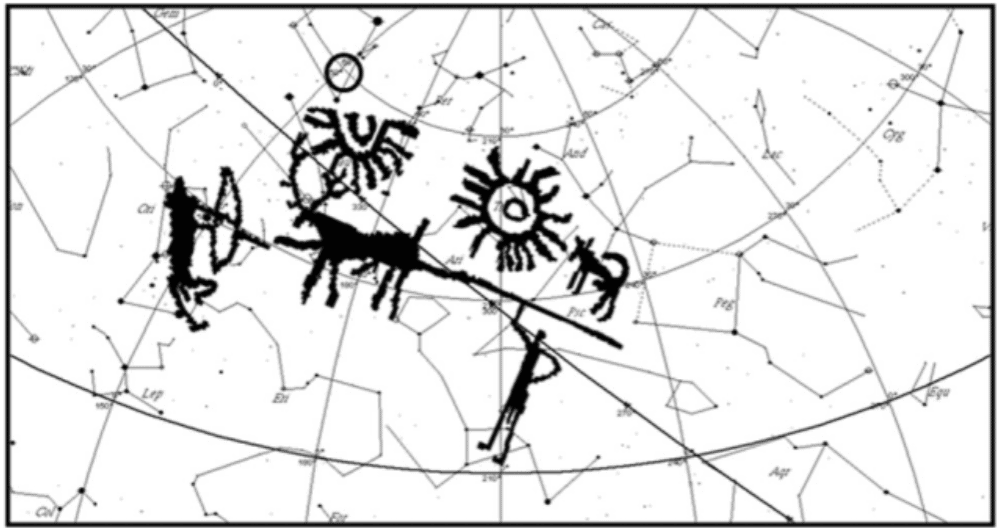A rock-art scene from India could hide an explosive secret. New research suggests that the inconspicuous scene might, in fact, represent the earliest ever star chart and the first supernova recorded by humanity.

Image credits Hrishikesh Joglekar et al., IJHS.
At first glance, there’s nothing too special about the piece. Sure, it’s really old — some 5,000 years old. Apart from that, however, it’s about what you’d expect art from the time to be: a couple of cave-guys hunting dinner with bows and spears.
But two elements in the drawing, found in the Northern Indian state of Kashmir and dated back to between 2100 and 4100 BC, caught the eye of astrophysicists at the Tata Institute of Fundamental Research in Mumbai: two objects shining brightly in the sky above the hunters.
Not all is as it seems
A new paper reports that the human and animal figures below the two objects bear an uncanny resemblance to star patterns in the night sky. This similarity led the authors to believe that the two circular objects seen above the hunting scene may represent the moon and sun — which, when you think about it, are not usually seen together.
The more exciting explanation is that what ancient people saw in the sky and then recorded on the rock was the sun/moon next to a supernova.
“In view of its nearly circular shape and same horizontal position of the two objects, comets, halos, and terrestrial events also seem unlikely,” the study reads. “We, therefore, consider the possibility that the observed object is a supernova.”
Supernovas are incredibly violent events that mark the death of certain massive stars. During a supernova, the star’s outer layers collapse in on the core with such ferocity that they compress it into a new, and much more dense body — a neutron star. The matter inside neutron stars is the densest material we yet know of. It’s packed so tightly that its atoms are squished, its electrons, protons, and neutrons standing shoulder to shoulder. For reference, a Hydrogen atom is roughly 99.9999999999996% empty space — just a proton, an electron, and nothing in between.
The dying star’s outer layers compress so rapidly that they eventually bounce off this jam-packed matter and explode outwards. The word “supernova” draws its roots in the Latin term nova, meaning ‘new’, as the stellar cores left over after novae and supernovae temporarily look like new stars in the sky, before fading away.
Luckily for us, the events are so ridiculously energetic that the X-rays they release allow us to detect and date them with pretty good accuracy, even thousands of years after the fact.
And that’s what the team did. They worked backward to see if any supernova visible from Earth occurred around the time the painting was created. Mayank Vahia, one of the paper’s co-authors, found that a supernova referred to as HB9 had indeed exploded sometime during 3600 BC.

Vahia also feels that the figures could actually be depictions of constellations. The man with the bow could indicate Orion, appropriately known in modern times as The Hunter and the one wielding a spear could be the constellation Pisces, the team explains. The deer they’re attacking bears a strong resemblance to Taurus, the Bull. The dog depicted in the work, the authors note, could represent the Andromeda galaxy. This theory is supported by the fact that the figures in the scene are placed similarly to where the constellations would be on a sky chart — even down to the ‘details’.
“These sky patterns account for all the bright stars in the region and look consistent with then prevalent culture,” the team explains. “As the constellations had iconographic importance in primitive cultures, exaggerated male organs of the four figures may have represented fertility.”
“However, some of these male organs can also be traced in the star patterns.”
All in all, the team is confident that we’re likely looking at humanity’s first sky chart to depict a supernova. The researchers are currently working with the Indira Gandhi National Centre for the Arts to scour the area for any other sky chart example — which, if found, would virtually confirm Vahia’s theory. An absence of such a second chart could suggest that the drawing is merely a coincidence, however, it’s possible that any copies were lost to the rigors of time. In the meantime, Vahia is confident that more rock art will be found to support his theory.
Fall the chips as they may, but I find it fascinating trying to imagine what these people thought when (and if) they saw that supernova blossoming in the sky.
The paper “Oldest sky-chart with Supernova record” has been published in the Indian Journal of History of Science.


